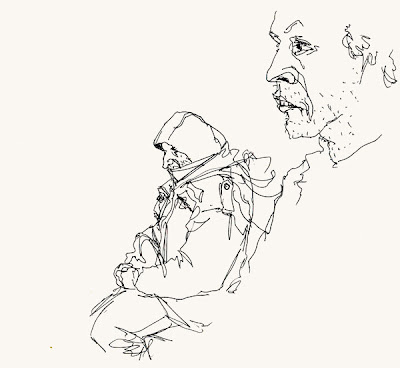Dienstag, 15. November 2011
ich war seit ewigkeiten mal wieder in friedrichshain. das motiv ist nicht sonderlich spannend, aber dafür sieht man (ein bisschen) die [f.u.c.]-bar. dort werden ab heute ein paar meiner bilder ausgestellt. wer interesse hat, ist herzlich eingeladen. ausstellungseröffnung ist um 19 uhr in der Travestraße 4 :-)
Montag, 7. November 2011
Sonntag, 6. November 2011
Mittwoch, 5. Oktober 2011
Interview mit Dan Archer
Hier ein Auszug aus unserer Korrespondenz (meine Fragen sind fett ausgezeichnet):
People often ask me why i’m drawing pictures instead of taking photos. I’m sure you are familiar with that question. What’s your take on this?
People often forget that photos can be editorialized just as much as drawn images. Personally, I think a drawing is all the more sincere in explicitly revealing that the object depicted has been run through a subjective filter. All too often do readers forget that even a photographer has to crop in/out the elements they don’t want in a frame, and that’s before the editor has their say. Not to mention the possibility of it being tampered with in photoshop. To me, drawn images are the most accurate way of translating what’s in our heads onto paper – crystallizing our subjective experience. Provided a journalist is up front about that, I don’t see what the problem is, beyond the traditional aversion to what’s innovative versus something that’s been traditionally accepted. [Perfect example: Newsweek’s cropping of a Dick Cheney photo in 2009, prompting the longest comment thread ever on the NYTimes Lens blog - http://lens.blogs.nytimes.com/2009/09/17/essay-9/]
Without doubt drawings provide a very subjective view of the subject. So, how do you create authenticity? One answer to that question can be found in your hypercomic: By clicking on a panel the reader gets access to supporting documents. Thats a great way to prove your assertions. But are there other possibilities to convince the reader that you are telling the truth?
Sources are always going to be the key to authenticity, and linking is certainly one of the best ways around that. Incorporating more multimedia, housing multiple, corroborative views together could be another. I don’t think one single “truth” exists – even if you and I experienced the same event next to each other, we’d record and report it differently.
What do you think are the advantages of a digital reportage over a printed one? Does interactivity really help to tell good and authentic stories? Couldn’t it be to complicated and confusing?
I think interactivity is one of the few ways of demanding a reader’s engagement and involvement – readers/viewers get let off too easily these days in the era of clicking off youtube videos or channel surfing. Only by forcing the reader to drive the story can we be sure they are fully committed to the narrative – much like the way agency works in between comics panels to make sequential images seem like they’re part of the same story. It could well be complicated – the key is marrying a compelling story with an intuitive interface – no mean feat! (Not to mention being paid well enough to make it in the first place).
Montag, 19. September 2011
Ringbahn
Freitag, 16. September 2011
Workshop „Ich glaube nur was ich sehe“

Bildreportagen haben grundsätzlich einen engen Bezug zur Realität. Bilder – unabhängig von ihrer Darstellungstechnik – sind jedoch immer durch den Autoren definierte, subjektive Interpretationen der Realität.
Im Rahmen eines Workshops untersuchte ich Bedingungen, unter denen Bilder vom Betrachter als glaubwürdig angesehen werden. Im Vorfeld der Veranstaltung sollte jeder der zwölf Teilnehmer zunächst eine Recherche vornehmen. Ziel war es jeweils ein Bild zu finden, dass für besonders glaubhaft gehalten wird und eines, das unglaubwürdig wirkt. In der Annahme, dass die Glaubwürdigkeit von Bildern nicht zwangsläufig von ihrer Darstellungstechnik abhängt, gab ich in dieser Hinsicht keinerlei Vorgaben. Illustrationen waren ebenso erlaubt wie Fotografien. Die Teilnehmer stellten ihre Ergebnisse zu Beginn des Workshops vor und begründeten ihre Auswahl. Im Anschluss wurden die Bilder in der Gruppe diskutiert. Die Resultate wurden anschließend in Form von Stichworten an einer Tafel gesammelt, sortiert und zusammengefasst. Auf diese Weise konnten eindeutige Attribute herausgearbeitet werden, die sich positiv oder negativ auf die Glaubwürdigkeit von Bildern auswirken.

Nachdem auf diese Weise die Glaubwürdigkeit von einzelnen Bildern eruiert wurde, sollte anschließend die Wirkung von Bildserien untersucht werden. Dabei lag die Vermutung zugrunde, dass der Kontext, in dem Einzelbilder präsentiert werden, einen Einfluss auf ihre Glaubhaftigkeit haben kann. Zu diesem Zweck sollten die Teilnehmer, ausgehend von einem einzelnen, unglaubwürdigen Bild, eine Bildserien erschaffen, die in ihrer Gesamtheit glaubwürdig wirkt. Dabei war auch der Einsatz von Text, Infografiken etc. erlaubt. Auf diese Weise sollten verschiedene Strategien erkennbar werden, mit denen Glaubwürdigkeit erzeugt werden kann. Auch diese Ergebnisse wurden nach der Übung von allen Teilnehmern gemeinsam diskutiert, kategorisiert und zusammengefasst.
Eine Dokumentation und die Ergebnisse des Workshops können hier heruntergeladen werden: klick
























